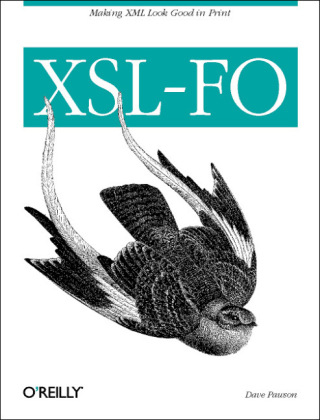
Xsl-fo
O'Reilly Media (Verlag)
978-0-596-00355-5 (ISBN)
No matter how flexible and convenient digital information has become, we haven't done away with the need to see information in print. Extensible Style Language-Formatting Objects, or XSL-FO, is a set of tools developers and web designers use to describe page printouts of their XML (including XHTML) documents. If you need to produce high quality printed material from your XML documents, then XSL-FO provides the bridge. XSL-FO is one of the few books to go beyond a basic introduction to the technology. While many books touch on XSL-FO in their treatment of XSLT, this book offers in-depth coverage of XSL-FO's features and strengths. Author Dave Pawson is well known in the XSLT and XSL-FO communities, and maintains the XSLT FAQ. An online version of this book has helped many developers master this technology. XSL-FO is the first time this reference is available in print. The first part of the book provides an overview of the technology and introduces the XSL-FO vocabulary. The author discusses how to choose among today's implementations, explains how to describe pages, and shows you what is going on in the processor in terms of layout.
You'll learn about the basics of formatting and layout as well as readability. The second part focuses on smaller pieces: blocks, inline structures, graphics, color and character level formatting, concluding by showing how to integrate these parts into a coherent whole. XSL-FO also explores organizational aspects you'll need to consider?how to design your stylesheets strategically rather than letting them evolve on their own. XSL-FO is more than just a guide to the technology; the book teaches you how to think about the formatting of your documents and guides you through the questions you'll need to ask to ensure that your printed documents meet the same high standards as your computer-generated content. Written for experienced XML developers and web designers, no other book contains as much useful information on this practical technology.
Dave Pawson maintains the XSLT and XSL-FO FAQ site. He got started with XML in 1997 while looking for a means of document reuse for multimedia presentation in print and braille for the Royal National Institute of the Blind (RNIB). He is the W3C Advisory Committee representative for the RNIB,and has supported the Web Accessibility Initiative since 1998. His background is in software development in the aerospace industry, followed by 5 years with RNIB, where he initially worked as a change agent, has more recently been monitoring web standards for accessibility. He has been heavily involved in the digital talking book inititiative coordinated by the DAISY consortium at www.daisy.org.
Preface 1. Planning for XSL-FO XML and Document Processing Choosing Your Print Production Approach Choosing Tools The Future for XSL-FO 2. A First Look at XSL-FO An XSL-FO Overview Related Stylesheet Specifications Using XSL-FO as Part of XSL Shorthand, Short Form, and Inheritance 3. Pagination Document Classes The Main Parts of an XSL-FO Document Simple Page Master Complex Pagination Page Sequences 4. Areas Informal Definition of an Area Area Types Components of an Area Reference Areas Area Positioning 5. Blocks Block Basics Blocks for Special Purposes Decorating Blocks Lists Tables Additional Material 6. Inline Elements Content Inline Styling Other Uses 7. Graphics and Color Graphics Basic Color Usage Color Specification Color Profiles Applicability 8. Styling at the Character Level General Character Properties Fonts 9. Cross-Document Links Cross-Document Links Indexing and Tables of Contents Running Headers 10. Putting It All Together Outline 11. Stylesheet Organization Classes of Stylesheets Page Layout Main Flows Inclusion and Importing A. How Do I Do That? B. Finding Your Way Around the Specification C. Today's Tools D. Objects, Properties, and Compliance Levels E. Inheritance Characteristics F. Examples for Chapter 10 G. Elements and Valid Properties H. GNU Free Documentation License (GFDL) Glossary Index
| Erscheint lt. Verlag | 24.9.2002 |
|---|---|
| Zusatzinfo | 1, black & white illustrations |
| Verlagsort | Sebastopol |
| Sprache | englisch |
| Einbandart | kartoniert |
| Themenwelt | Mathematik / Informatik ► Informatik ► Web / Internet |
| ISBN-10 | 0-596-00355-2 / 0596003552 |
| ISBN-13 | 978-0-596-00355-5 / 9780596003555 |
| Zustand | Neuware |
| Haben Sie eine Frage zum Produkt? |
aus dem Bereich



